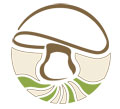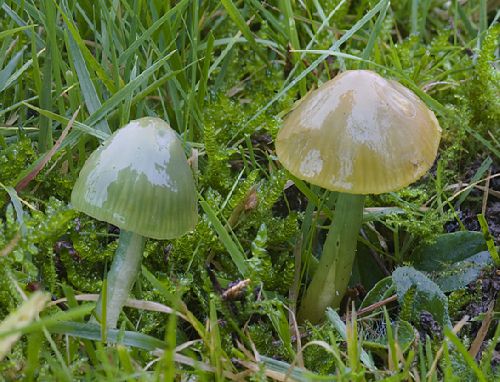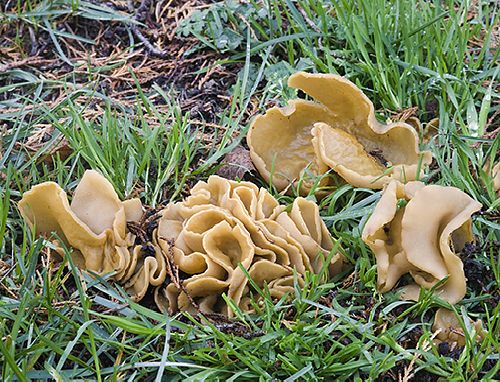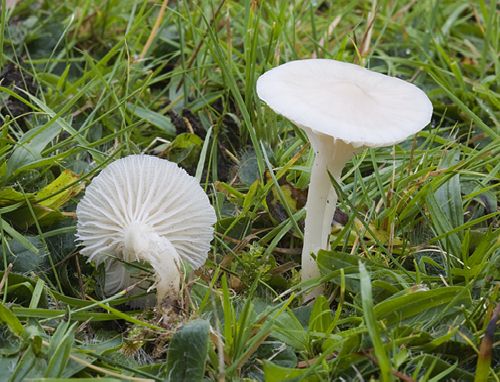Romsey Cemetery
Sat 20 Nov 2010
Field event ID HF1026
OS Grid areas: SU3611
Weather: The weather is getting more wintery but at least it was not raining for an outing to the cemetery.
Report: (Eric + Sue) As expected it was mainly grassland species that were found, while others were often too young or too old to be able to identify. Interestingly, considering it was near enough the same time of year as we visited last year, there were not so many species even taking into account the fact that many will not be identified. Eric was inundated with specimens to identify as there was no one else willing or able to undertake this job. The photographers had some good specimens to add to their collection, although which of the yellow spindles were Clavulinopsis helvola, C fusifomis or C luteoalba might need a little sorting out. Sue found Geoglossum cookeanum which was there last year while Eric added Trichoglossum hirsutum to the list along with a repeat find of Ramaria eumorpha, which was again fruiting prolifically in the graves under one of the Cedars. While the diversity was limited, some of the saprophytic fungi were present in abundance, with large rings of Clitocybe nebularis (Clouded Agaric), Lepista flacida (Tawny Funnel Cap), Lepista nuda (Wood Blewit) and the odiferous Clitocybe fragrans. One interesting find was a troop of yellow fungi emerging from the turf. These turned out to be Hypholoma fasiculare (Sulphur Tuft) which we can only suppose was growing on one of the coffins! The mystery of the day was a collection of large cups which we took to be Otidea. On examination, they had warty spores which led to suggestions of a Peziza, despite the lack of blueing in iodine. Finally, following Sherlock Holmes dictum, they were identified as Sowerbyella radiculata, confirmed by Brian Spooner at Kew. (Ed: Previously known from Northington and Dorset but the VC11 part) The group abandoned foraying at lunch time but Eric remained to show some friends of the cemetery around the fungal display. It is interesting that despite our efforts it was not until the afternoon we found the iconic Hygrocybe calyptriformis. Oh, and we did find some Xylaria hypoxylon !
Species list: Agaricus macrocarpus, Agaricus sylvaticus, Baeospora myosura, Boletus subtomentosus, Chlorophyllum rachodes, Clavulina coralloides, Clavulinopsis corniculata, Clavulinopsis fusiformis, Clavulinopsis helvola, Clavulinopsis luteoalba, Clitocybe fragrans, Clitocybe nebularis, Clitocybe vibecina, Cystoderma amianthinum, Galerina clavata, Geoglossum cookeanum, Gliophorus psittacinus, Gymnopus dryophilus, Hemimycena lactea, Hygrocybe calyptriformis var. calyptriformis, Hygrocybe ceracea, Hygrocybe chlorophana, Hygrocybe coccinea, Hygrocybe fornicata var. fornicata, Hygrocybe pratensis var. pratensis, Hygrocybe virginea var. virginea, Hygrophoropsis aurantiaca, Hypholoma fasciculare var. fasciculare, Laccaria laccata, Lactarius hepaticus, Lepiota ochraceofulva, Lepista flaccida, Lepista nuda, Lycoperdon perlatum, Marasmius oreades, Melanoleuca polioleuca, Mycena diosma, Mycena stipata, Ramaria eumorpha, Rhodocollybia butyracea, Rickenella fibula, Scleroderma bovista, Scleroderma citrinum, Sowerbyella radiculata var. radiculata, Trichoglossum hirsutum var. hirsutum, Xylaria hypoxylon




.jpg)
